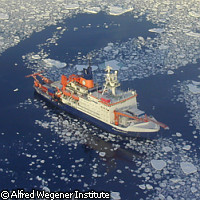Arctic sea ice in 2008 likely to reach second lowest level ever, scientists predict
This summer, the Arctic sea ice will probably not shrink below the record low observed in 2007. However, it is highly likely that there will be less ice than in 2005, the year with the second lowest sea ice extent ever measured. These predictions come from scientists on the EU-funded DAMOCLES ('Developing arctic modelling and observing capabilities for long-term environmental studies') project. The scientists' forecast is based on a specially designed computer model developed at the Alfred Wegener Institute (AWI) in Germany. 'After the strong decrease of the Arctic ice during the last summer, climate scientists all around the world are constantly asked: how will the ice develop in the next years?' explains Professor Rüdiger Gerdes of the AWI. 'To answer this question, we did not want to guess, but to rely on sound calculations.' The extent of the Arctic sea ice in summer is largely determined by changes in the atmosphere during the melting season as well as the thickness of the ice at the beginning of the season. The ocean-sea ice model contains atmospheric data stretching back 20 years and incorporates the key dynamic and thermodynamic equations which govern the interactions between ice and ocean. Among other things, the model calculates oceanic circulation, temperature, salinity, sea ice drift, ice thickness and ice concentration. When data from early 2007 was entered into the model, it correctly predicted the presence of large ice free areas in the middle of the Arctic Ocean later on in the year. The model predicts with a probability of 80% that the minimum sea ice extent in 2008 will be between 4.16 and 4.70 million square kilometres. The chances of 2008 beating 2007's record low of 4.3 million square kilometres are just 8%. However, the odds are that the ice cover will be smaller than in 2005, the second lowest year on record with a minimum ice extent of some 5.6 million square kilometres. In comparison, the average minimum ice coverage in the early 1980s was around 7 million square kilometres. The AWI is not the only team to have made a prediction regarding this year's ice cover; scientific teams from around the world have made predictions on the basis of a range of methods in the framework of a contest run by DAMOCLES and its sister project in the US, SEARCH ('Study of environmental Arctic change') project. 'It is a first test, and all participating researchers are eager to know how their prognosis has fared at the end of the summer, commented Professor Gerdes. 'In the end, this small competition serves the optimisation of our models, so that we are able to improve our predictions concerning short-term seasonal fluctuations.' DAMOCLES is funded under the 'Sustainable development, global change and ecosystems' thematic area of the EU's Sixth Framework Programme (FP6).



